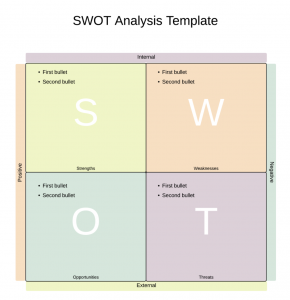This assignment intends to provide a difficult definition of a technical term using technical writing skills. This difficult technical term that is going to be explained is the SWOT Analysis.
Parenthetical Definition: SWOT Analysis is used in the business field to evaluate companies.
Sentence Definition: SWOT Analysis is an efficient framework applied in the business field to help companies to evaluate their situations and decide future planning.
Expanded Definition: SWOT Analysis is a useful framework helping a company to analyze its strengths, weaknesses, opportunities, and threat from various aspects and therefore, helping a company to find out their competitive positions as well as future strategies.
History: SWOT Analysis was created by Albert Humphrey (2005) who was a management consultant at the Stanford Research Institute. He found out that there were so many companies not able to achieve success because they were lacking an efficient long-term plans based on their own situations. He and his team created SWOT Analysis to help companies to make their own long-term plans accountably and objectively.
Steps of SWOT Analysis
SWOT stands for Strengths, Weaknesses, Opportunities, and Threats of a company. The template of a SWOT Analysis is in Table 1.
 Table 1
Table 1
To conduct a SWOT Analysis, the company needs to choose a particular aspect that they want to focus on, for example, potential market that they want to explore.
Strengths: the competitive abilities that a company has that are better than other companies. For example, things that a company is good at or good qualities that can make one company shine than other companies.
Weaknesses: the abilities that a company doesn’t have but are quite important. For instance, things that one company are short of or limited sources.
Opportunities: areas or fields that have fewer competitors. For example, certain business markets that doesn’t have too many competitors.
Threats: external things that might lead to a company fail. For instance, strong competitors or lacking customers.
SWOT Analysis not only can be used in the business field but also in some other parts, for instance, future career strategies or even a trip plan could also use SWOT Analysis.
Works Cited
Helms, Marilyn M., and Judy Nixon. “Exploring SWOT analysis–where are we now?.” Journal of strategy and management (2010).
Hill, Terry, and Roy Westbrook. “SWOT analysis: it’s time for a product recall.” Long range planning 30.1 (1997): 46-52.
Houben, Ghislain, Kwan Lenie, and Koen Vanhoof. “A knowledge-based SWOT-analysis system as an instrument for strategic planning in small and medium sized enterprises.” Decision support systems 26.2 (1999): 125-135.
Humphrey, Albert S. “SWOT analysis.” Long Range Planning30 (2005): 46-52.
Humphrey, Albert S. “The origins of the SWOT analysis model.” SWOT Analysis, by Alan Chapman, www. bussinessballs. com (2004): 63-69.
Rizzo, Albert “Skip, and Gerard Jounghyun Kim. “A SWOT analysis of the field of virtual reality rehabilitation and therapy.” Presence: Teleoperators & Virtual Environments 14.2 (2005): 119-146.
Leave a Reply